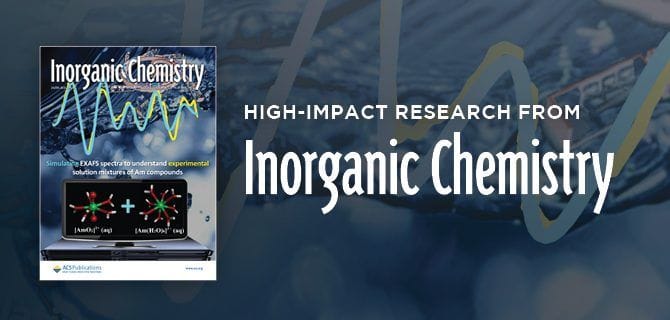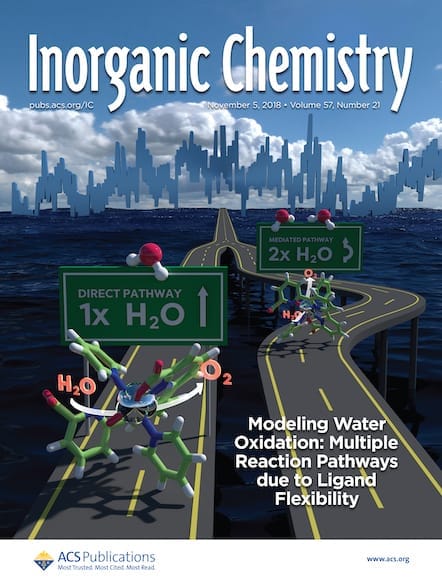Inorganic Chemistry publishes fundamental studies in all phases of inorganic chemistry and has earned respect throughout the world for attracting and publishing outstanding research. We invite you to explore this selection of the journal’s most-cited articles. From the New Trends and Applications for Lanthanides special issue: Strategies toward High-Temperature Lanthanide-Based Single-Molecule Magnets Inorg. Chem., 2016, 55 […]

Inorganic Chemistry publishes fundamental studies in all phases of inorganic chemistry and has earned respect throughout the world for attracting and publishing outstanding research. We invite you to explore this selection of the journal’s most-cited articles.
From the New Trends and Applications for Lanthanides special issue:
- Strategies toward High-Temperature Lanthanide-Based Single-Molecule Magnets
Inorg. Chem., 2016, 55 (20), pp 10043–10056
DOI: 10.1021/acs.inorgchem.6b01353
Research Articles
A Robust Luminescent Tb(III)-MOF with Lewis Basic Pyridyl Sites for the Highly Sensitive Detection of Metal Ions and Small Molecules
Inorg. Chem., 2016, 55 (7), pp 3265–3271
DOI: 10.1021/acs.inorgchem.5b02294
Uncommon Pyrazoyl-Carboxyl Bifunctional Ligand-Based Microporous Lanthanide Systems: Sorption and Luminescent Sensing Properties
Inorg. Chem., 2016, 55 (8), pp 3952–3959
DOI: 10.1021/acs.inorgchem.6b00217
Lead-Free MA2CuClxBr4–x Hybrid Perovskites
Inorg. Chem., 2016, 55 (3), pp 1044–1052
DOI: 10.1021/acs.inorgchem.5b01896
Unique (3,4,10)-Connected Lanthanide–Organic Framework as a Recyclable Chemical Sensor for Detecting Al3+
Inorg. Chem., 2016, 55 (10), pp 4790–4794
DOI: 10.1021/acs.inorgchem.6b00190
Exceptionally Robust In-Based Metal–Organic Framework for Highly Efficient Carbon Dioxide Capture and Conversion
Inorg. Chem., 2016, 55 (7), pp 3558–3565
DOI: 10.1021/acs.inorgchem.6b00050
Single-Crystal to Single-Crystal Phase Transition and Segmented Thermochromic Luminescence in a Dynamic 3D Interpenetrated AgI Coordination Network
Inorg. Chem., 2016, 55 (3), pp 1096–1101
DOI: 10.1021/acs.inorgchem.5b02200
An Ultrastable Europium(III)–Organic Framework with the Capacity of Discriminating Fe2+/Fe3+ Ions in Various Solutions
Inorg. Chem., 2016, 55 (20), pp 10114–10117
DOI: 10.1021/acs.inorgchem.6b01876
Fluorescent Aromatic Tag-Functionalized MOFs for Highly Selective Sensing of Metal Ions and Small Organic Molecules
Inorg. Chem., 2016, 55 (5), pp 2261–2273
DOI: 10.1021/acs.inorgchem.5b02666
An Anion Metal–Organic Framework with Lewis Basic Sites-Rich toward Charge-Exclusive Cationic Dyes Separation and Size-Selective Catalytic Reaction
Inorg. Chem., 2016, 55 (5), pp 2641–2649
DOI: 10.1021/acs.inorgchem.6b00019
Special Issues
- Metal-Organic Frameworks for Energy Applications
- Halide Perovskites
- Small Molecule Activation: From Biological Principles to Energy Applications Part 3
Don’t Miss It! Inorganic Chemistry Explores the 5 Stages of Rejection
Manuscript rejection is a normal part of the scientific publishing process. It happens to all researchers, from novices to Nobel Laureates, at one time or another. Intellectually that makes sense—especially when it happens to someone else—but what should you do when a rejection notice shows up in your inbox?
